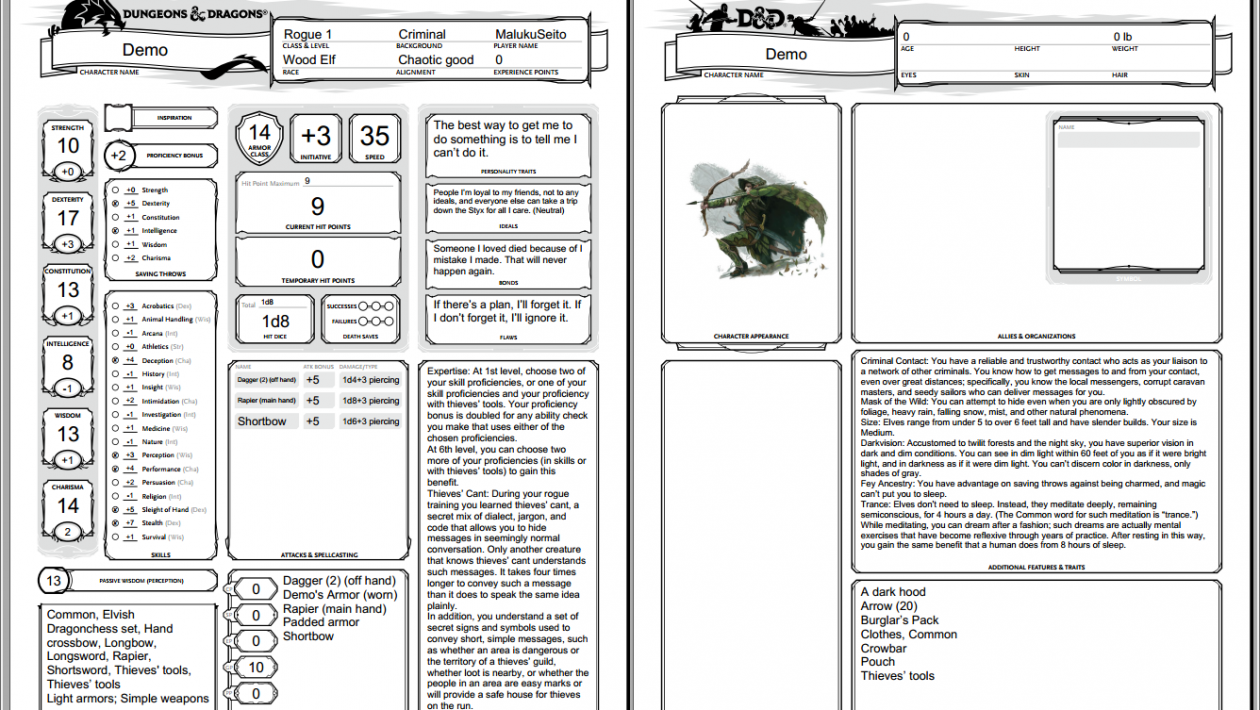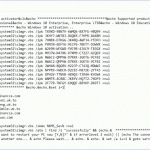One theme that will appear in the player profession sooner or later is character creation. Some people like d&d 5e character creator creation altogether. Others are afraid of work related to it. As another player, this task can be overwhelming without any information about what is needed.
Since the initial notice, I will not make this guide anymore. I accept this information is not essential. It is not too much, but take a little control in the “Player Manual” (PHB page 11). For some people, this data is sufficient, and this is how I make characters. In any case, I am not everyone. There are a few people who are struggling with character creation.
Table of Contents
d&d 5e character creator in this guide
I need to make the whole article correct. I am not your dungeon master. All the methods I provide are not a substitute for DM’s way of character creation. My idea is to chat with your DM while reading this guide. Use it as the beginning of the discussion. We should do several roles.
To save this article from prolonged growth, I hope you (the reader) understand the game and the character table enough to record the highlights you get from your decision-making. If you are interested, I can discuss more up and down the standard character table’s various parts.
I will not involve multi-classification. Suppose you are using this manual to make your first character. In that case, I don’t recommend you enter the multi-category because it will increase the complexity and make the character creation more complicated.
Phase 1: Role concept
In case PHB does not involve one thing, then manage it to talk about the central idea of the role. For now, if you are not worried about causing a fascinating character, or until now you have a name you need to play, please do not hesitate to avoid this development.
Whenever I start to make a character, I need to put in all the all-encompassing time frames. I usually try to consider the improvement test from the character’s thinking. The pitch of a new name I made called “Cutting Edge Shield” is “a robot that is usually taken over and entrusted to fix it.” It is simple, straightforward, and gives you a place to make the rest of the character. I will use Blade-Shield as a model to use several methods to resolve decisions that depend on this lift. This elevated tone is what you should submit to the DM for endorsement because you may be playing in their scenes, and they may be the storytellers.
If you are struggling with this boosting pitch, I suggest you research the settings you will use. In situations where you may need zero requirements, it is often troublesome to think of something new, so please sort out every invention imperative to set up and help narrow the prospects. Conceptualizing with different participants is another way to help concoct this. Web-based media is also a great place to get character ideas. Trying to figure out where the character’s picture comes from reveals the shadow to a visually impaired person. You will be aware of its existence but still tricky to figure out.
The second stage: competition of d&d 5e character creator
This is a fundamental essential improvement. When you pitch with a lift, you can figure out which game to choose from. For Blade-Shield, I decided on an unearthed treasure competition called Warforged, which is essentially a D&D robot. If your lift pitch does not quickly separate from the race you should choose, start to study the races used in the mission settings carefully. After making this decision, pay attention to the worksheet’s quality and remember the changes in the capacity score, as these changes will be significant in the future.
As a side note, I know that it is not the best plan to include characters in games that are not compatible with the game in this part of the article. I did this for different attributes of characters later in this guide. I have extensive knowledge of D&D 5e’s non-standard substances. Also, I stipulate that your first role is to comply with the player manual. When you are interested in your interests, you will find some assets for finding non-standard playable games.
Stage 3: Select the background
I was shocked when I found out that this news could not be found in the PHB management. Given that every foundation is proficient in skills and equipment, this is of great significance. In the process of character creation, this is usually the easiest part of the character to miss. I even often ignore its reality. Each foundation combines descriptions of skills and equipment.
Now you may encounter the problem of acquiring the expertise and capabilities you currently have. This may happen if you choose a game that gains additional abilities allowed by experience. If nothing unique happens, you won’t choose other features, you won’t be proficient, you won’t raise $200, and you won’t pass Go.
Change: What caught my attention is that there are other principles under the “Proficiency” section on page 125 of the Player Handbook:
If a d&d 5e character creator obtains similar abilities from two unique sources, the individual in question can choose a similar kind of alternative ability (ability or equipment) from all considerations.
If you do encounter a copy function, please choose another to get a similar position. For example, if the foundation you choose is Sailor and you select the race Elf, you can get two Perceptions with similar functions. In any case, because of this standard, you will choose other professional skills than equipment features by then.
This is where it is usually stipulated that crates marked with personality traits, ideals, bonds, and defects should be rounded. The foundation of your choice has several tables where you can find ideas, but nothing more. You can put aside the work of organizing more roles now, or you can stand by until you decide on the greater use of the part. Sometimes, it helps move out the details or pick your class before rounding up because you may not consider the role thoroughly. In any case, rounding this content may prompt you to think about the type you need or the advanced thinking of what ability scores should be zeroed out.
With Blade-Shield, I chose the Soldier Foundation because I think they are conflict machines from the past. Their personality traits were legitimate and later became flawed. So, their standard is to protect nature at the expense of themselves. Their bond is that their memories are adulterated and outdated, and the entire gap needs to be filled. Their flaws are more complicated.
Role defect of d&d 5e character creator
For us, it’s easy to be a fantastic d&d 5e character creator. We can’t blame it anyway and always stick to the right choice, especially when we first started making the character. I found these characters to be terrible. When the name does everything consistently, without drama, it’s a grand narrative. I encourage everyone to concoct some defects, and you will encounter some troubles in the game.
For Blade-Shield, his main flaw is that they can’t distinguish between being neat and lying, and they will collect most of the information that the character suggests to him. This may prompt me to encounter the best pretense in my lasting memory. This defect is not necessarily the main one. It may be as simple as accumulating a spoon, wanting to take away anything uncertain. Regardless of the good omen for your character, the most potent saint is often more flawed than the story describes.
Step 3.5: Align
I remember this is further progress because it is often a lively topic. So far, I have asked players not to make any arrangements, but this is exactly how we play. Your DM may ask you to place an appointment. The discussion of various formats is too long for this article, so I suggest you read this page (PHB page 122, Basic Rules page 34).
Stage 4: Choose a course
This advancement may be the main advancement you want to make in determining your gaming insight into D&D. This is because a large part of your highlights come from and will come from your team. Your class will even decide when to get a capacity score upgrade. Choosing a course will also figure out what ability scores you need, and your principal center will be the opportunity to generate ability scores. In general, this is not an easy stage.
As long as you choose your course, this will determine your savings toss ability, ability level, health status, and hardware (I will introduce later). Help you choose according to your pitch (and, if possible, character attributes). You are choosing race and foundation before the group will ensure that you don’t need to go back to the level of expertise because you accidentally chose one of this two knowledge previously given to you.
With Blade-Shield, I have two options. Mainly druids, but due to their fighter base and more natural conflicts, I don’t think it is appropriate. I chose the Paladin of the Ancient Oath. Here, it is beneficial to have more information about what is accessible. I realized that his attention would be focused on strength. I plan to reduce the number of characters with zero spelling because my past roles have fascinated me with the possibility of a non-spelling paladin. Their spell opening was wholly used to destroy. The blessed image of the sharp Hilde Hilde will be the flowers blooming on their heads, and you can imagine the reason for his failure. Who can say with certainty that perhaps the flowers are controlling them?
Stage 5: Generate ability score
Before you start the professional knowledge check and save the throw, you need to get the ability score. Creating this content involves the broadest way that the player and the DM can decide to execute it. Every DM has its tendencies, and you need to talk to them before doing this. I will introduce various ways to solve this problem. Whenever you get an ability score, try to add the race modifier obtained from the race selected in step 2.
Move for them
This is the most famous method I have seen and one of the ways I use it. The centerpiece of this is that you can use the dice to calculate your ability score. The most widely recognized route is to move four d6s and keep the most notable three or six times. At this point, you will use these numbers and select the capacity score to enter.
Indeed, even this has changed. I asked the player to use the 4d6 drop times to move a unique number arrangement at least twice. At that time, I let the players choose which part of the two sets of matches they need to use for ability scoring. I do this to indicate movement in extreme situations, such as moving all capacity scores below ten or the entire score is entirely normal. Similarly, I have seen requests for detailed information to figure out which ability scores they are related to, thus avoiding decisions about players’ hands.
Standard array
There is a digital magic list, which D&D calls a standard array. This is a summary of numbers that can be used for the character’s capacity score. The exhibition is:
15, 14, 13, 12, 10, 8
Take each number and assign it to your preferred capacity score. This is my decision-making strategy when making pre-generated characters because it can make everyone at a similar professional level and their snapshot ability. As you will see, the difference between this strategy and the mobile strategy is that for the capacity score, the maximum score is 15, and the rolling score is 18. Compared with the dangers of rolling, this method is more stable.
Finally, make sure that any highlights or abilities that notice the ability score modifier try to fill it with that modifier (for example, Dragonborn’s breathing weapon, Paladin’s hand on the body). This includes some abilities. Once you have your powers, these abilities will also increase your ability rewards. Treat saves equivalent to capabilities while generating tips. One number you may see on the role chart related to your commands is “passive perception.” This number is only ten or more of the perceived rewards you get.
end of d&d 5e character creator
That should be everything! It may seem like a lot, but ideally, this guide will help you learn how to make a character, not just around the structure.












I really liked this article you shared. Thanks for taking the time to write it